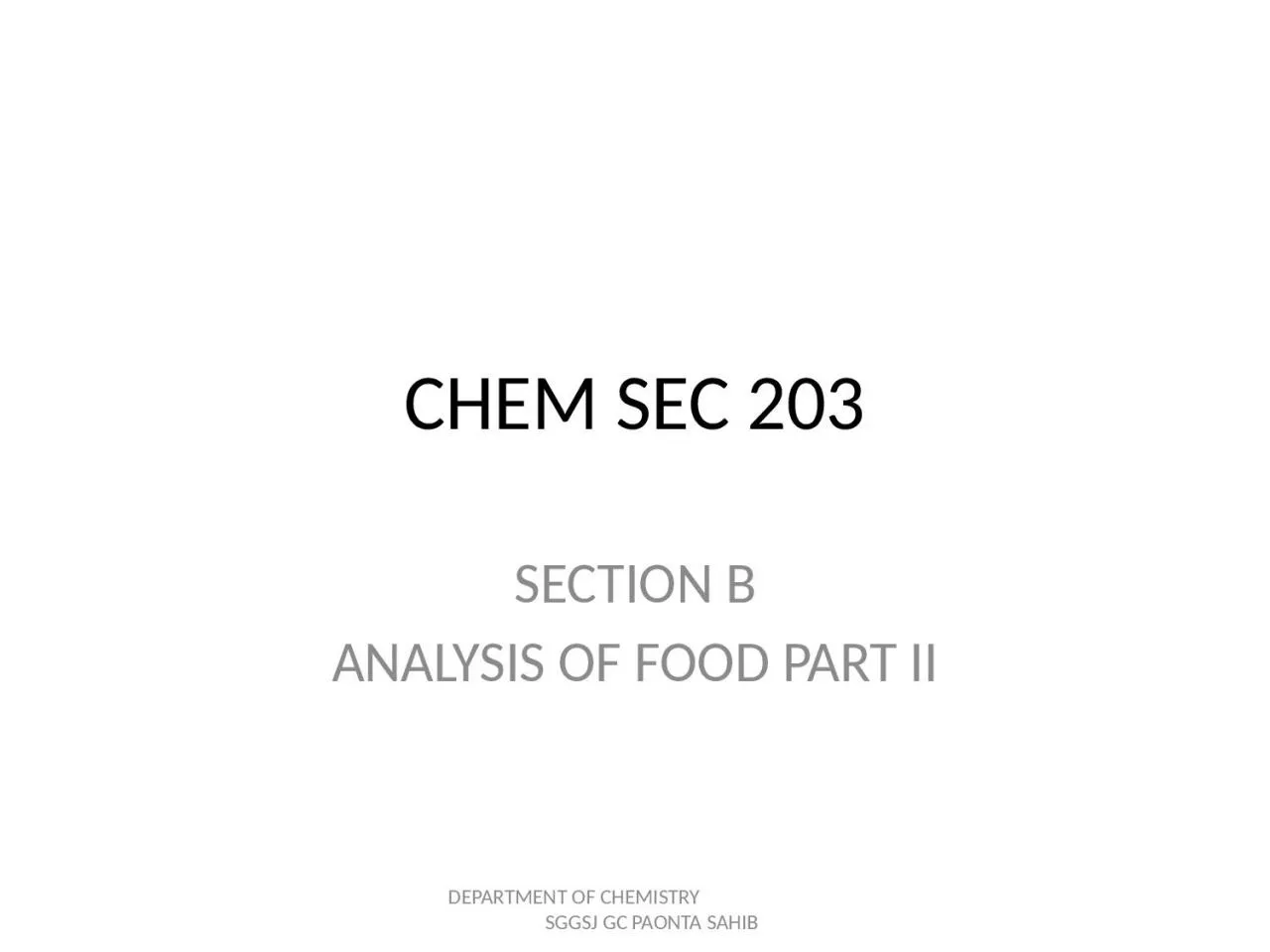

DEPARTMENT OF CHEMISTRY SGGSJ GC PAONTA SAHIB FOOD PROCESSING Set of methods and techniques used to transform raw ingredients into food or to transform food into other forms for consumption by humans and animals both ID: 1034920
Download Presentation The PPT/PDF document "CHEM SEC 203 SECTION B ANALYSIS OF FOOD ..." is the property of its rightful owner. Permission is granted to download and print the materials on this web site for personal, non-commercial use only, and to display it on your personal computer provided you do not modify the materials and that you retain all copyright notices contained in the materials. By downloading content from our website, you accept the terms of this agreement.
1. CHEM SEC 203SECTION BANALYSIS OF FOOD PART IIDEPARTMENT OF CHEMISTRY SGGSJ GC PAONTA SAHIB
2. FOOD PROCESSINGSet of methods and techniques used to transform raw ingredients into food or to transform food into other forms for consumption by humans and animals both.Aims of Processing food is :To prevent ,reduce and eliminate infestation of food with microbes ,insects or worms.To prevent or slow down the microbial growth and inhibit the deteriorative chemical reactionsTo maintain and imorove the nutritinal properties of food.To increase the shelf life of food.DEPARTMENT OF CHEMISTRY SGGSJ GC PAONTA SAHIB
3. Benefits of food processingRemoves toxins from food.Preserves the food.Increases food consistency.Easy for marketing and distribution.Reduces incidences of food borne diseases.DEPARTMENT OF CHEMISTRY SGGSJ GC PAONTA SAHIB
4. Drawbacks of food processingMay affect nutritional value of food.Flavours used may be unhealthy.There is risk of food contamination.DEPARTMENT OF CHEMISTRY SGGSJ GC PAONTA SAHIB
5. Operations involved in food processingSTEPS Handling and storage of raw materialsExtractionProduction processAddition of food additivesDEPARTMENT OF CHEMISTRY SGGSJ GC PAONTA SAHIB
6. Operations in food processingDEPARTMENT OF CHEMISTRY SGGSJ GC PAONTA SAHIB
7. Operations in food processingDEPARTMENT OF CHEMISTRY SGGSJ GC PAONTA SAHIB
8. Classification of food additivesFood additives are classified as:PreservativesColouring agents or food colours.Flavouring agents.Artificial sweetening agents.Nutrient supplements.DEPARTMENT OF CHEMISTRY SGGSJ GC PAONTA SAHIB
9. PreservativesWhat is food preservation ?How is it done?When the prepared food is treated to stop down or slow the spoilage without altering the natural characteristics of food ,it is food preservation.Steps in food preservationHeatingOxidationInhibiting toxinsDehydrationLow temperature inactivationPasteurisationDEPARTMENT OF CHEMISTRY SGGSJ GC PAONTA SAHIB
10. Different preservatives used for foodNatural preservativessalt.lemon juice.grapefruit seed extract.Rosemary extract.sugar.citric acid (from citrus fruits)Artificial preservativesBenzoatesSorbates – including potassium sorbate, calcium sorbate and sodium sorbatePropionatesNitrites Antioxidants that inhibit oxidation:Sulfites, including sodium sulfite, sodium bisulfite, sodium metabisulfite, potassium bisulfite and potassium metabisulfite.Vitamin E (tocopherol)Vitamin C (ascorbic acid)Butylated hydroxyanisole (BHA) – a waxy solid used in the preservation of butter, lard, meats, etc.SODIUM GLUTAMATEDEPARTMENT OF CHEMISTRY SGGSJ GC PAONTA SAHIB
11. What are Class I and Class II preservativesCLASS I PRESERVATIVECOMMON SALTSUGARGLUCOSESPICESVINEGARHONEYEDIBLE VEG OILSAddition of these preservatives is not restrictedCLASS II PRESERVATIVEBenzoic acid and its derivativeSO2SORBIC ACIDSODIUM DIACETATEBUTYLATED HYDROXY ANISOLEBUTYLATED HYDROXY TOLUENEUse of class II Preservatives is restricted.DEPARTMENT OF CHEMISTRY SGGSJ GC PAONTA SAHIB
12. DEPARTMENT OF CHEMISTRY SGGSJ GC PAONTA SAHIB
13. Methods of food preservationDEPARTMENT OF CHEMISTRY SGGSJ GC PAONTA SAHIB
14. FLAVOURING AGENTSFlavouring agents are key food additives with hundreds of varieties like fruit, nut, seafood, spice blends, vegetables and wine which are natural flavouring agents. Besides natural flavours there are chemical flavours that imitate natural flavours.Besides natural flavours there are chemical flavours that imitate natural flavours. Some examples of chemical flavouring agents are alcohols that have a bitter and medicinal taste, esters are fruity, ketones and pyrazines provide flavours to caramel, phenolics have a smokey flavour and terpenoids have citrus or pine flavour.MSG is a common synthetic flavouring agent.Amyl actate is for banana flavour,ethyl butyrate for pineapple,methyl anthranilate for grapes.DEPARTMENT OF CHEMISTRY SGGSJ GC PAONTA SAHIB
15. Analysis of food coloursGive methods to detect the following food colours:Caramel .Turmeric. Annatto.Chlorophyll.DEPARTMENT OF CHEMISTRY SGGSJ GC PAONTA SAHIB
16. Analysis of food coloursDEPARTMENT OF CHEMISTRY SGGSJ GC PAONTA SAHIB
17. Detrmination of synthetic food colour for samples containing single colourDEPARTMENT OF CHEMISTRY SGGSJ GC PAONTA SAHIB
18. Single colour determination(Contd from previous slide).DEPARTMENT OF CHEMISTRY SGGSJ GC PAONTA SAHIB
19. Paper chromatography for determining mixture of coloursDEPARTMENT OF CHEMISTRY SGGSJ GC PAONTA SAHIB
20. Some questions for practiceWhat are antimicrobial food preservatives?Write short note on Pasteurization of milk?Write short note on irradiation of food as method of preservation?What are Anti enzymatic preservatives?How is chromatography used to separate a mixture of food colours?How is colorimetry ued to determine synthetic food colour in food products?Write short note on nutrient supplementDEPARTMENT OF CHEMISTRY SGGSJ GC PAONTA SAHIB